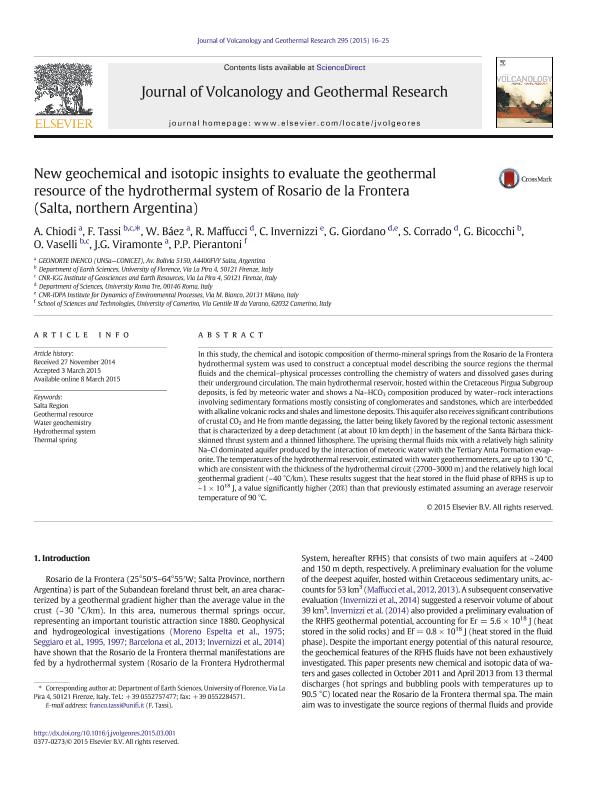Mostrar el registro sencillo del ítem
dc.contributor.author
Chiodi, Agostina Laura

dc.contributor.author
Tassi, F.
dc.contributor.author
Baez, Walter Ariel

dc.contributor.author
Maffucci, R.
dc.contributor.author
Invernizzi, C.
dc.contributor.author
Giordano, G.
dc.contributor.author
Corrado, S.
dc.contributor.author
Bicocchi, G.
dc.contributor.author
Vaselli, O.
dc.contributor.author
Viramonte, Jose German

dc.contributor.author
Pierantoni, P.P.
dc.date.available
2018-07-02T19:59:41Z
dc.date.issued
2015-03
dc.identifier.citation
Chiodi, Agostina Laura; Tassi, F.; Baez, Walter Ariel; Maffucci, R.; Invernizzi, C.; et al.; New geochemical and isotopic insights to evaluate the geothermal resource of the hydrothermal system of Rosario de la Frontera (Salta, northern Argentina); Elsevier Science; Journal of Volcanology and Geothermal Research; 295; 3-2015; 16-25
dc.identifier.issn
0377-0273
dc.identifier.uri
http://hdl.handle.net/11336/50926
dc.description.abstract
In this study, the chemical and isotopic composition of thermo-mineral springs from the Rosario de la Frontera hydrothermal system was used to construct a conceptual model describing the source regions the thermal fluids and the chemical-physical processes controlling the chemistry of waters and dissolved gases during their underground circulation. The main hydrothermal reservoir, hosted within the Cretaceous Pirgua Subgroup deposits, is fed by meteoric water and shows a Na-HCO3 composition produced by water-rock interactions involving sedimentary formations mostly consisting of conglomerates and sandstones, which are interbedded with alkaline volcanic rocks and shales and limestone deposits. This aquifer also receives significant contributions of crustal CO2 and He from mantle degassing, the latter being likely favored by the regional tectonic assessment that is characterized by a deep detachment (at about 10km depth) in the basement of the Santa Bárbara thick-skinned thrust system and a thinned lithosphere. The uprising thermal fluids mix with a relatively high salinity Na-Cl dominated aquifer produced by the interaction of meteoric water with the Tertiary Anta Formation evaporite. The temperatures of the hydrothermal reservoir, estimated with water geothermometers, are up to 130°C, which are consistent with the thickness of the hydrothermal circuit (2700-3000m) and the relatively high local geothermal gradient (~40°C/km). These results suggest that the heat stored in the fluid phase of RFHS is up to ~1×1018J, a value significantly higher (20%) than that previously estimated assuming an average reservoir temperature of 90°C.
dc.format
application/pdf
dc.language.iso
eng
dc.publisher
Elsevier Science

dc.rights
info:eu-repo/semantics/openAccess
dc.rights.uri
https://creativecommons.org/licenses/by-nc-sa/2.5/ar/
dc.subject
Geothermal Resource
dc.subject
Hydrothermal System
dc.subject
Salta Region
dc.subject
Thermal Spring
dc.subject
Water Geochemistry
dc.subject.classification
Meteorología y Ciencias Atmosféricas

dc.subject.classification
Ciencias de la Tierra y relacionadas con el Medio Ambiente

dc.subject.classification
CIENCIAS NATURALES Y EXACTAS

dc.title
New geochemical and isotopic insights to evaluate the geothermal resource of the hydrothermal system of Rosario de la Frontera (Salta, northern Argentina)
dc.type
info:eu-repo/semantics/article
dc.type
info:ar-repo/semantics/artículo
dc.type
info:eu-repo/semantics/publishedVersion
dc.date.updated
2018-06-29T13:03:47Z
dc.journal.volume
295
dc.journal.pagination
16-25
dc.journal.pais
Países Bajos

dc.journal.ciudad
Amsterdam
dc.description.fil
Fil: Chiodi, Agostina Laura. Consejo Nacional de Investigaciones Científicas y Técnicas. Centro Científico Tecnológico Conicet - Salta. Instituto de Investigaciones en Energía no Convencional. Universidad Nacional de Salta. Facultad de Ciencias Exactas. Departamento de Física. Instituto de Investigaciones en Energía no Convencional; Argentina
dc.description.fil
Fil: Tassi, F.. University of Florence. Department of Earth Sciences; Italia. Institute of Geosciences and Earth Resources; Italia
dc.description.fil
Fil: Baez, Walter Ariel. Consejo Nacional de Investigaciones Científicas y Técnicas. Centro Científico Tecnológico Conicet - Salta. Instituto de Investigaciones en Energía no Convencional. Universidad Nacional de Salta. Facultad de Ciencias Exactas. Departamento de Física. Instituto de Investigaciones en Energía no Convencional; Argentina
dc.description.fil
Fil: Maffucci, R.. Università di Roma; Italia
dc.description.fil
Fil: Invernizzi, C.. Institute for Dynamics of Environmental Processes; Italia
dc.description.fil
Fil: Giordano, G.. Università di Roma; Italia. Institute for Dynamics of Environmental Processes; Italia
dc.description.fil
Fil: Corrado, S.. Università di Roma; Italia
dc.description.fil
Fil: Bicocchi, G.. University of Florence. Department of Earth Sciences; Italia
dc.description.fil
Fil: Vaselli, O.. University of Florence. Department of Earth Sciences; Italia. Institute of Geosciences and Earth Resources; Italia
dc.description.fil
Fil: Viramonte, Jose German. Consejo Nacional de Investigaciones Científicas y Técnicas. Centro Científico Tecnológico Conicet - Salta. Instituto de Investigaciones en Energía no Convencional. Universidad Nacional de Salta. Facultad de Ciencias Exactas. Departamento de Física. Instituto de Investigaciones en Energía no Convencional; Argentina
dc.description.fil
Fil: Pierantoni, P.P.. University of Camerino; Italia
dc.journal.title
Journal of Volcanology and Geothermal Research

dc.relation.alternativeid
info:eu-repo/semantics/altIdentifier/doi/https://dx.doi.org/10.1016/j.jvolgeores.2015.03.001
dc.relation.alternativeid
info:eu-repo/semantics/altIdentifier/url/https://www.sciencedirect.com/science/article/pii/S0377027315000578
Archivos asociados
